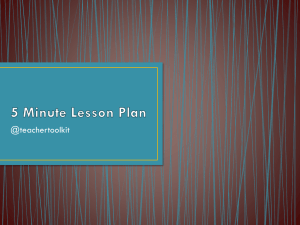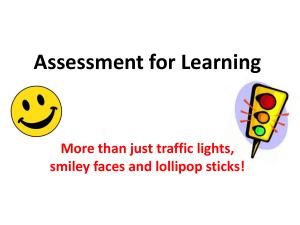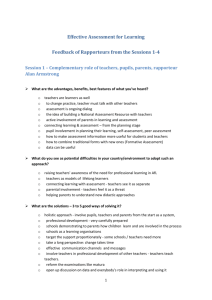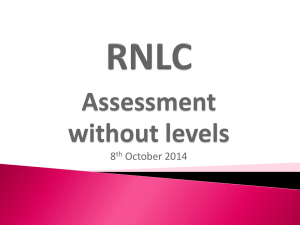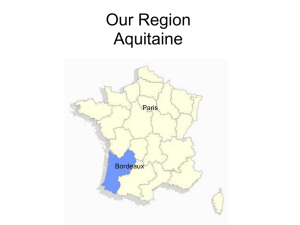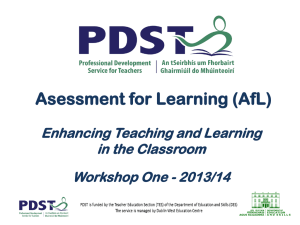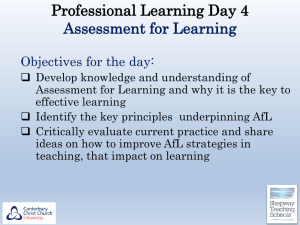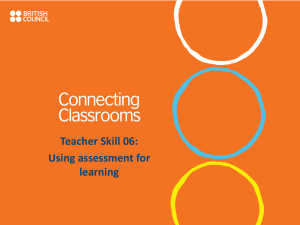AFL Presentation
advertisement
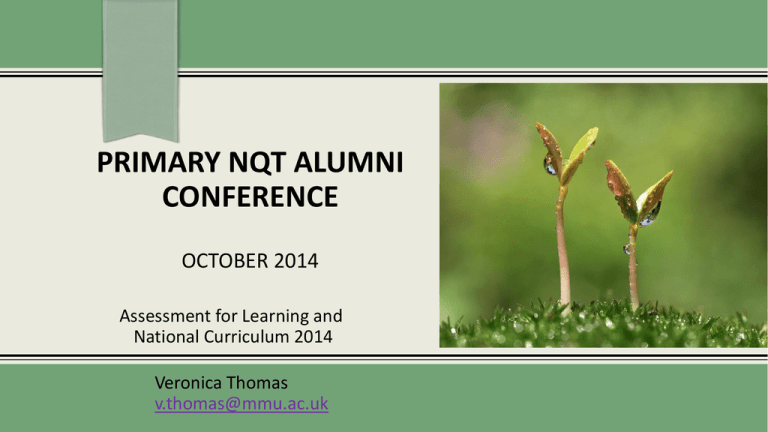
PRIMARY NQT ALUMNI CONFERENCE OCTOBER 2014 Assessment for Learning and National Curriculum 2014 Veronica Thomas v.thomas@mmu.ac.uk AfL - what's it all about? National Curriculum 2014 - Taking a view! Outstanding curriculum! What's that? Putting it all together! Outline of the session Assessment … What do you think of when you hear this word? Formative Formative assessment does not count towards final course grades directly, but measures progress and provides students with valuable feedback Summative Summative assessment counts towards final results in relation to learning outcomes Accountability - The current stance ‘Ofsted will expect to see evidence of pupils’ progress, with inspections informed by the school’s chosen pupil tracking data.’ Primary assessment and accountability under the new National Curriculum, DfE, July 2013 “Inspectors will … want to see how well schools are responding to changes to the national curriculum from September [2014]. Every headteacher should be asking themselves the sort of questions that we will be asking when we inspect schools in the weeks and months ahead: How is the school’s assessment model linked to the programmes of study and schemes of work in the new curriculum?” Sir Michael Wilshaw - head of Ofsted http://www.ofsted.gov.uk/resources/north-of-england-educationconference-2014-hmci-speech, extract from speech at the North of England Education Conference on the 14th January 2014. I DfE principles Effective assessment systems N F Give reliable information to parents about how their child, and their child’s school, is performing O a. Allow meaningful tracking of pupils towards end of key stage expectations in the new curriculum, including regular feedback R to parents. M b. Provide information which is transferable and easily understood and covers both qualitative and quantitative I assessment. Differentiate attainment between pupils of different abilities, N c.giving early recognition of pupils who are falling behind and G those who are excelling. d. Are reliable and free from bias. I DfE principles - Effective assessment systems M P Help drive improvement for pupils and teachers R a. Are closely linked to improving the quality of teaching. O b. Ensure feedback to pupils contributes to improved learning and is focused on specific and tangible objectives. V c. Produce recordable measures which can demonstrate I comparison against expected standards and reflect progress over time. N G I DfE principles Effective assessment systems N N Make sure the school is keeping up with external best O practice and innovation a. Are created in consultation with those delivering best V practice locally. A b. Are created in consideration of, and are benchmarked T against, international best practice I N G As a % of pupils in the year that have achieved their targets Using ‘milestones’ (beginning/develop ing/secure) Monitoring teacher performance Against expected progress (for pupils, and for groups) Identifying key vulnerable groups (such as pupil premium, SEN, etc) Identifying underperforming groups Key terminology! Assessment is derived from Latin ‘assidere’ to sit with or beside. It is something we do with and for a student, not something we do to them. (Wiggins, cited in Green, 1998) Assessment of Learning (AoL) - more closely associated with Summative Assessment Assessment for Learning (AfL) - more closely associated with Formative Assessment O R I G I N S What is assessment for learning? (AfL) Dylan Wiliam , emeritus professor, University of London's Institute of Education Paul Black emeritus professor, from King's College London Co authors of ‘Inside the Black Box’ (1998) Analogies! 9 hours - east Lands London? Next! If pilots flew like teachers assess…? Analogies! Analogy ‘…if we think of our children as plants … summative assessment of the plants is the process of simply measuring them. The measurements might be interesting to compare and analyse, but in themselves, they do not affect the growth of the plants. Formative assessment on the other hand, is the garden equivalent of feeding and watering plants‐directly affecting their growth.’ Shirley Clarke . (2001), Unlocking Formative Assessment Measuring learning! - Structure of Observed Learning Outcome http://www.johnbiggs.com.au/academic/solo-taxonomy/ The SOLO Taxonomy with sample verbs indicating levels of understanding Competence Identify Name Follow simple procedure Combine Describe Enumerate Perform serial skills List Analyse Apply Argue Compare/ contrast Criticize Explain causes Relate Justify Create Formulate Generate Hypothesize Reflect Theorize .... Fail Incompetent Misses point Incompetence Prestructural one relevant aspect Unistructural several relevant independent aspects integrated into a structure Multistructural Relational generalized to new domain Extended Abstract Principles of AfL Clarifying, sharing and understanding learning intentions. Eliciting evidence of pupil learning, through the use of ‘tests’ and quizzes, for example. Providing feedback that moves learning forward. Using pupils as learning resources for one another, through methods such as peer assessment and peer tutoring. Encouraging pupils to be owners of their own learning, through self- assessment and other methods. S T A Y I N G O N T R A C K What does AfL look like in the classroom? Minute by minute adjustments! Day by day adaptations! Successful effective feedback! Good feedback that causes thinking! Choices - Protection or Growth! Recognition and Meta Cognition - fixed ability/fixed mindset or growth ability/growth mindset N E X T S T E P S I N L E A R N I N G AfL - what's it all about? Word associations! Word associations! Acknowledge or Judge Prompt or Halt Propel or Repress Pass or Fail Motivate or Hinder Evaluate or Appraise Review or Test Commentary or Comment Further reading and practical resources Journey to Excellence - Dylan Wiliam but also a wealth of other videos too http://www.journeytoexcellence.org.uk/videos/expertspeakers/feedbackonlearningdylan wiliam.asp How not to talk to your kids! - Considerations around mindset http://nymag.com/news/features/27840/ John Hattie on Visible learning and effect size http://visible-learning.org/2013/02/john-hattie-presentation-maximising-the-impactvideo-transcript/ Counter considerations for problematising and synthesis http://meridianvale.wordpress.com/2014/01/25/what-if-feedback-wasnt-all-it-wascracked-up-to-be/ AfL strategies to try! http://www.slideshare.net/mikegershon/afl-toolkit National Curriculum 2014 - Taking a view! Some BIG questions! What is the concept of education? What is education for? What exactly do we mean when we talk about the curriculum and is this distinguishable from a National Curriculum? If so, in what ways? If it was up to you what would choose to put into a National Curriculum? Outstanding curriculum! What's that? 1. is underpinned by aims, values and purpose 2. develops the whole person - knowledge, skills, understanding and attitudes 3. is broad, balanced and has clear progression in subject knowledge and skills The top 10 hallmarks of an outstanding curriculum… 4. is filled with rich first-hand purposeful experiences 5. is flexible and responsive to individual needs and interests 6. embeds the principle of sustainability 7. has an eye on the future and the needs of future citizens 8. encourages the use of environments and expertise beyond the classroom 9. makes meaningful links between areas of knowledge across the curriculum and the major issues of our time 10. has a local, national and international dimension How can we develop a well designed curriculum that does this? ‘The big idea is – know thy impact! Expert teachers are not wedded to specific teaching strategies – rather, they regularly focus on evaluating the effects they have on students, and adjust teaching methods accordingly. When teaching and learning are “visible” – that is, when it is clear what teachers are teaching and what students are learning, student achievement increases. ‘ John Hattie Hattie Research - Visible Learning School effects Teacher effects Teaching effects Student effects Curricula effects Home effects Average effect size of all the interventions he studied was 0.40. The top ten! http://www.treasury.govt.nz/publications/mediaspeeches/guestlectures/pdfs/tgls-hattie.pdf http://www.treasury.govt.nz/publications/mediaspeeches/guestlectures/pdfs/tgls-hattie.pdf The other end! http://www.treasury.govt.nz/publications/mediaspeeches/guestlectures/pdfs/tgls-hattie.pdf The in-betweners! http://www.treasury.govt.nz/publications/mediaspeeches/guestlectures/pdfs/tgls-hattie.pdf http://www.treasury.govt.nz/publications/mediaspeeches/guestlectures/pdfs/tgls-hattie.pdf Putting it all together! Back to the start then but the ball in firmly in your court! AfL strategies! - Pros and cons! National Curriculum - Being that ‘conduit’! Being and Becoming a teacher - Growing an identity! Seeing the bigger picture! Divergent thinking! Criticality! Synthesis! Further reading and practical resources Shirley Clarke Active Learning Through Formative Assessment (2008) Guy Claxton Building Learning Power: Helping Young People Become Better Learners (2002) Carol Dweck Mindset: The New Psychology of Success (2007) Dylan Wiliam and Paul Black Inside the Black Box: v. 1: Raising Standards Through Classroom Assessment (2006) T One final thought! H A John Hattie on the art of teaching N “… the act of teaching reaches its epitome of success after the lesson has been structured, after the content has been delivered, and after the K classroom has been organised. The art of teaching, and its major Y O U successes, relate to “what happens next” – the manner in which the teacher reacts to how the student interprets, accommodates, rejects and/or reinvents the content and skills, how the student relates and applies the content to other tasks, and how the student reacts in light of success and failure apropos the content and methods that the teacher taught. Learning is spontaneous, individualistic, and often earned through effort. It is a timeworn, slow, gradual, fits-and-starts kind of process, which can have a flow of its own, but requires passion, patience, and attention to detail (from the teacher and the student)”.
